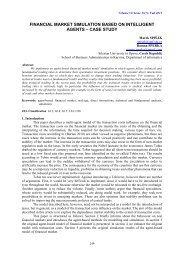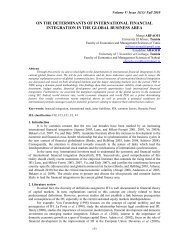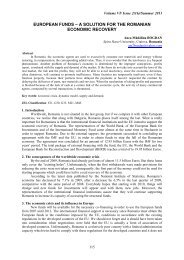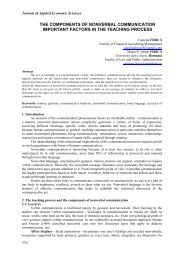giurca vasilescu.pdf - JAES | Journal of Applied Economic Sciences
giurca vasilescu.pdf - JAES | Journal of Applied Economic Sciences
giurca vasilescu.pdf - JAES | Journal of Applied Economic Sciences
Create successful ePaper yourself
Turn your PDF publications into a flip-book with our unique Google optimized e-Paper software.
<strong>Journal</strong> <strong>of</strong> <strong>Applied</strong> <strong>Economic</strong> <strong>Sciences</strong><br />
VolumeI_Issue1 (1)_2006<br />
ACTUAL CONSIDERATIONS CONCERNING<br />
THE INDIVIDUAL CREDIT RISK<br />
Laura Giurca Vasilescu<br />
University <strong>of</strong> Craiova, Romania<br />
Faculty <strong>of</strong> <strong>Economic</strong>s and Business Administration<br />
Cătălina Sitnikov<br />
University <strong>of</strong> Craiova, Romania<br />
Faculty <strong>of</strong> <strong>Economic</strong>s and Business Administration<br />
Nicoleta Fota<br />
University <strong>of</strong> Craiova, Romania<br />
Faculty <strong>of</strong> <strong>Economic</strong>s and Business Administration<br />
Abstract:<br />
The credit risk is one <strong>of</strong> the most dangerous category <strong>of</strong> banking risks because it covers a wide range <strong>of</strong><br />
products and services. In the last years we were the witnesses to an intensification <strong>of</strong> the negative impact <strong>of</strong> this<br />
kind <strong>of</strong> risk at the international level. In the transition economies, the credit risk’s potential was<br />
overdimensioned by the various evolutions <strong>of</strong> the companies and their debt level.<br />
Key words: credit risk; bank lending;<br />
1. Introduction<br />
Any credit represents an anticipation <strong>of</strong> future payments. From this perspective, the stream <strong>of</strong><br />
receipts, any credit bears the risk that these payments to partially made or not at all. This risk is also<br />
known as creditor’s insolvability risk; it is essential in banking as a bank main function is to grant<br />
credits. Therefore, the correct estimation <strong>of</strong> the credit risk is <strong>of</strong> great importance for a bank. As it is<br />
easier to prevent than to fix, in order to reduce the risk exposure, the most important stage in the<br />
lending process is to select the credit applications.<br />
In this phase a bank behavior can be presented as follows: a credit can not be granted only if it<br />
can be estimated that the payment possibility exceeds the non-payment one. The estimation <strong>of</strong><br />
payment capacity can be made, based on various procedures, depending on the debtor: economic<br />
agent, private person, state.<br />
The credit analysis represents the evaluation process <strong>of</strong> the credit risk. The credit risk must be<br />
appreciated depending on what the bank expects to obtain pursuant to this credit. The lending process<br />
is likely a pr<strong>of</strong>it bearer; the later being classified in two categories: direct pr<strong>of</strong>its and indirect pr<strong>of</strong>its.<br />
Direct pr<strong>of</strong>its are immediate and, frequently, quantifiable. The most important ones are the<br />
interest and the bank commission. To these is added the client account minimum credit balance, a<br />
balance representing the credit guarantee.<br />
Indirect pr<strong>of</strong>its are more difficult to quantify and doubtful. Granting a credit can also call forth<br />
to begin and maintain a relation, a deposit growth and also an increase for requesting other bank<br />
services. All these pr<strong>of</strong>its must be taken into consideration when analyzing the risk exposure and,<br />
eventually, accepted.<br />
2. Credit analysis is a process which must be periodically run: before the credit in order to take the<br />
lending decision and then, depending on the credit term, at determined time intervals, usually when the<br />
client financial reports are made available.<br />
The determinant elements <strong>of</strong> the individual administration risk are the following: payment<br />
capacity, debtor character – his will to make the payment, the capital – the debtor’s belongings,<br />
guarantee (real or personal), environmental conditions. Among all these five factors, the first one is the<br />
most important.<br />
19
<strong>Journal</strong> <strong>of</strong> <strong>Applied</strong> <strong>Economic</strong> <strong>Sciences</strong><br />
VolumeI_Issue1 (1)_2006<br />
It is though that the main weaknesses in estimating <strong>of</strong> the credit risk are <strong>of</strong> internal type: faulty<br />
selection <strong>of</strong> files and improper internal supervision <strong>of</strong> the evolution (actually <strong>of</strong> the involution) <strong>of</strong> the<br />
debtors’ quality. The risk <strong>of</strong> improper file selection can be reduced by: rigour concerning the file<br />
content, internal appreciation <strong>of</strong> the clients’ quality on unitary basis, by score, double agreement <strong>of</strong> the<br />
lending decision and establishment <strong>of</strong> a tolerance correspondent to the perceived interested.<br />
There are high value credits and various ones concerning the maturities, destinations,<br />
guarantees. For a long time their selection had been exclusively made depending on the experience,<br />
interpretation <strong>of</strong> information and the business feeling the bankers have. Also now there are two ways<br />
to handle a credit application: the classical approach and the modern one.<br />
In the classical approach there are evaluated and compared two elements: the financing needs<br />
and the credit application.<br />
The financing needs can be for investments or for exploitation.<br />
The investments financing needs are characterized by high values and the punctual character <strong>of</strong><br />
the application. The file for the investment project can be elaborated by the company (potential client),<br />
by an expert or even by the bank. The elaboration <strong>of</strong> the file for the client investment project is the<br />
preferred method, if the bank has enough resources and the necessary expertise (qualified personnel).<br />
This is the most advantageous solution as it provides additional pr<strong>of</strong>its for the bank, the implication <strong>of</strong><br />
its own specialist in evaluations <strong>of</strong> investment projects and a uniform data base which allows the<br />
establishment <strong>of</strong> an unitary algorithm for evaluating the clients’ projects.<br />
The analysis <strong>of</strong> the financing need is performed in a provisional financing plan: there are<br />
analyzed the needs and the perspective, gross, financial resources, then completed with banking<br />
credits. For this type <strong>of</strong> projects the prudence rule which must be observed is that the bank must never<br />
finance entirely the client investment project.<br />
The financial needs <strong>of</strong> current expenses have other characteristics: have smaller values and are<br />
relatively permanent. These types <strong>of</strong> needs can be determined by planning the working capital or<br />
inside the treasury plan. It is absolutely necessary that the bank clerk responsible for the relation with<br />
the respective client to check both the information and the algorithm which stood the basis <strong>of</strong> the<br />
financing need. Afterwards the banker can propose an adequate “financial montage”, namely a<br />
combination <strong>of</strong> short term credits to cover the client need for financing.<br />
The second stage in the credit analysis using the classical approach is the study <strong>of</strong> the credit<br />
application. The analysis <strong>of</strong> the associated risk means implicates to follow the next stages:<br />
identification, evaluation and prevention <strong>of</strong> credit risk.<br />
The identification and evaluation <strong>of</strong> the credit risk means to define it, the major causes <strong>of</strong> risk<br />
and the quantification <strong>of</strong> the risk exposure. The credit risk is caused by disturbances in the cash flow<br />
forecasted when analyzing the lending application. For each debtor these disturbances can generate<br />
insolvability. The factors generating insolvability can be classified into external factors and internal<br />
factors without being able to make the difference between the two categories in respect to the<br />
amplitude <strong>of</strong> risk exposure generated.<br />
Internal factors are almost entirely associated to a faulty management: that is why, the<br />
appreciation <strong>of</strong> the pr<strong>of</strong>essionalism <strong>of</strong> the management team or <strong>of</strong> the partner himself (in case <strong>of</strong> small<br />
companies), is a highly important element in the analysis process <strong>of</strong> the credit risk. Also, one must<br />
appreciate the debtor character – his will to make payments implicated by the credit granted. This is<br />
extremely difficult to appreciate in case <strong>of</strong> new clients and needs extensive information.<br />
External factors – related to client – can be classified into political, economic and banking<br />
factors. They act over an entire group <strong>of</strong> clients and, that is why, their evaluation and identification is<br />
made for sectors <strong>of</strong> activity, by the bank specialists, using also internal information. Small banks can<br />
buy analyzing services from the bigger institutions or from specialized researched institutes, but, in<br />
this case, they can not use the internal information protected by the bank department.<br />
The traditional approach is based on relatively laborious procedures and has a series <strong>of</strong><br />
restrictions which can not be easily ignored: most decisions are preponderantly subjective, the<br />
information analysis is sequential, and the process last longer and has a higher cost.<br />
The modern approach <strong>of</strong> the credit analysis is based on credit scoring. The credit scoring<br />
represents the credit evaluation based on score.<br />
20
<strong>Journal</strong> <strong>of</strong> <strong>Applied</strong> <strong>Economic</strong> <strong>Sciences</strong><br />
VolumeI_Issue1 (1)_2006<br />
By introducing and generalizing the evaluation based on score it was intended to achieve some<br />
specific objects, among which:<br />
increment <strong>of</strong> credit quality by formalizing and imposing unique credit norms;<br />
reduce the evaluation cost by standardizing the procedures and by using the expert systems<br />
or some algorithms;<br />
increment <strong>of</strong> productivity and inspectors satisfaction by eliminating routine activities, the<br />
increment <strong>of</strong> their responsibilities;<br />
improvement <strong>of</strong> the performances for the control procedures <strong>of</strong> credits, inspectors, operative<br />
units;<br />
facilitate the changes in the credit strategy;<br />
clients selection depending on quality;<br />
formalization <strong>of</strong> procedures and minimization <strong>of</strong> subjective errors and risks.<br />
The current operation <strong>of</strong> the evaluation based on score supposes the observance <strong>of</strong> the following<br />
stages:<br />
the identification <strong>of</strong> the main features <strong>of</strong> the credit file; among these there must be selected<br />
maximum ten, due to their relatively low degree <strong>of</strong> variables independence (statically speaking);<br />
the percentage <strong>of</strong> the selected features;<br />
(re)calculation <strong>of</strong> the credit score by cumulating the attributed points;<br />
establish the category to which the credit belongs to.<br />
In the stage <strong>of</strong> implementation <strong>of</strong> the evaluation system are essential the procedure to establish<br />
the limits and the model testing.<br />
Lending the private persons represent a different banking domain although, for a very long time,<br />
lending someone, especially on short time, seemed suspicious as the life over the means one can<br />
dispose <strong>of</strong>. Traditionally, families usually degage an surplus <strong>of</strong> financial resources, and appealing to<br />
credits was an exceptional phenomenon, generated by unique events, as buying a house or a car. The<br />
credits grated to private persons are not so pr<strong>of</strong>itable for banks and only the reduction <strong>of</strong> traditional<br />
markets determined the banks to extend also in the area <strong>of</strong> credits for private persons. In Romania this<br />
market is little developed, where are dominating the banking traditional activities to credit the<br />
companies, sufficiently pr<strong>of</strong>itable activities, due to the lack <strong>of</strong> a normal development <strong>of</strong> the financial<br />
markets to facilitate the direct transfer <strong>of</strong> financial resources. But it is expected that, once the rise <strong>of</strong><br />
population real incomes, the re-launching <strong>of</strong> economy and extending the companies use <strong>of</strong> other<br />
financing methods different from the credit, the banks to direct also toward this domain to fructify the<br />
funds they are administrating. Moreover, these small values credits are quite diversified in portfolio by<br />
destinations, guarantees and debtors.<br />
The credits contracted by the private persons are <strong>of</strong> two types: short term credits to cover any<br />
temporary gaps between the incomes and expenditures and long term credits for financing real estate<br />
investments. In order to analyze the clients credit files, the banks are using two methods: classical<br />
approach and the modern one.<br />
The essence <strong>of</strong> the classical approach for analyzing the private credit consists in appreciating the<br />
applicant repayment capacity, so that the instalments (including the interests) to be reasonable in<br />
comparison with his average incomes. Most <strong>of</strong> the time, granting the credit also implies the<br />
constitution <strong>of</strong> certain guarantees for the possible case when the risk <strong>of</strong> insolvability may occur. In<br />
case <strong>of</strong> private persons files, the analysis for the financial needs is minimum, as it follows, in case<br />
there is an object to be credited, its value to be real, but this stage is imposed more by the need to<br />
check the guarantees <strong>of</strong>fered, for the cases when the good purchased is the guarantee for the creditor.<br />
Therefore, the essence <strong>of</strong> the analysis process <strong>of</strong> the credit is the analysis <strong>of</strong> the credit application.<br />
Depending on their destination, the short term private credits are consumer credits and personal<br />
credits.<br />
Consumer credits are granted for purchasing goods with installment payment, goods which<br />
generally represents also the credit guarantee. On the market <strong>of</strong> these types <strong>of</strong> credits the banks are<br />
highly concurred by consumer credit companies and credit cooperatives.<br />
Personal credits are usually restricted no matter <strong>of</strong> the clients’ incomes and the credit<br />
destination, because these information are not even requested by the bank. It lends a certain amount (a<br />
21
<strong>Journal</strong> <strong>of</strong> <strong>Applied</strong> <strong>Economic</strong> <strong>Sciences</strong><br />
VolumeI_Issue1 (1)_2006<br />
limited <strong>of</strong>fer, usually twice-third time the average <strong>of</strong> monthly income) with a precise maturity and an<br />
interest <strong>of</strong> the installment relatively high; the client can use the money as he likes on the condition to<br />
repay at the maturity; this is a developing market where banks run an aggressive competition.<br />
Identification and evaluation <strong>of</strong> the insolvability causes is done for two distinct groups:<br />
objective causes, referring to the activity environment and the subjective ones referring especially to<br />
client character. Depending on the nature <strong>of</strong> incomes (salary or others), <strong>of</strong> their quantity and<br />
periodicity, <strong>of</strong> the existence for other payment commitments and <strong>of</strong> the client character, the bank can<br />
establish the payment possibility is highly enough in order to grand the credit.<br />
The protection is performed differently depending on the causes; for the objective,<br />
environmental, important is the existence and the permanency <strong>of</strong> incomes, but also the repayment<br />
capacity. There are three practical rules for reducing the short term credit risks by analyzing the client<br />
credit application: the credit must have a reasonable value, there should be stable sources <strong>of</strong> income<br />
and there should not exist any previous payment incidents. The observance <strong>of</strong> these common sense<br />
rules can not guarantee the entire repayment <strong>of</strong> the credits granted and also the fact that the solvable<br />
creditors can not be rejected, but it eliminates the most <strong>of</strong> the repayment incidences.<br />
For middle and long term credits its scope is to buy or to perform works to real estate assets.<br />
The credit value is sensible higher for short term credits. The causes <strong>of</strong> insolvability are the<br />
same as with a probability <strong>of</strong> a higher occurrence, because it is a long term credit. The protection is<br />
more difficult to be performed, because the longer term raises the incertitude, referring to both the<br />
incomes and the debtor behavior. So, it is imposed the request for guarantees under the form <strong>of</strong> life<br />
insurances for debtor and the bank as beneficiary and under the form <strong>of</strong> mortage and other forms for<br />
legal guarantees.<br />
The moderate approach based on credit scoring sees to synthetize the non repayment risk by<br />
means <strong>of</strong> a note. The procedure is usually used for short term credits so that:<br />
these credits have smaller values, so the analysis <strong>of</strong> the file can not be expensive;<br />
the files must be solved quickly because the applicants would like to know the answer as<br />
soon as possible, so that they can eventually apply to another bank;<br />
the debtors should have a certain behavior integrity, so that the decisional criteria to be valid<br />
for all and to come on scoring based evaluation;<br />
also the credits, in their turn, must be comparable as amount, scope <strong>of</strong> the credit and<br />
maturity so that the risk to be comparable.<br />
3. Conclusions<br />
The organization and the structure <strong>of</strong> the lending process for private clients can be used as<br />
effective instruments in reducing the risk exposure. Their conscious use in this precise scope stands at<br />
the base <strong>of</strong> the actively preventive administration <strong>of</strong> the client risk.<br />
The classical approach in this domain (the relative way to administrate the lending process) is<br />
based on the direct organization <strong>of</strong> the lending activity at the level <strong>of</strong> two bank departments: the desk<br />
or front <strong>of</strong>fice charged with the elaboration <strong>of</strong> credit files and sorting them and the private credit <strong>of</strong>fice<br />
or the back <strong>of</strong>fice which provides the administration <strong>of</strong> the events subsequent to credit approval,<br />
during the progress <strong>of</strong> the relation with the debtor. In this context the risk administration is<br />
concentrated at the level <strong>of</strong> the front <strong>of</strong>fice where files are being selected using various procedures<br />
among which credit scoring and protection against risks is provided by requesting the traditional<br />
guarantees.<br />
Once the lending process is initiated, the incidences are handled as a department for debt<br />
collection and only the worst cases drive the start <strong>of</strong> a legal department dangerous for the institution<br />
(high costs). In the crisis periods is registered an accelerate rise <strong>of</strong> the numbers <strong>of</strong> files with problems.<br />
The classical reaction <strong>of</strong> credit institutions implies on one hand, the modification <strong>of</strong> evaluation limits<br />
based on scoring, and on the other hand the rise <strong>of</strong> effectives assigned to the department <strong>of</strong> debt<br />
collection. This group <strong>of</strong> answers represents a reactive way <strong>of</strong> action only after the incident took place.<br />
This is a dangerous policy, because <strong>of</strong>ten is too late to be able to recover the entire debt, and the<br />
expenses can be significant (in comparison to the credit amount). Therefore the chain <strong>of</strong> file<br />
administration starts with it elaboration by the front <strong>of</strong>fice personnel. The identification and the<br />
22
<strong>Journal</strong> <strong>of</strong> <strong>Applied</strong> <strong>Economic</strong> <strong>Sciences</strong><br />
VolumeI_Issue1 (1)_2006<br />
evaluation <strong>of</strong> the risk are generally made and depending on this general evaluation, the bank involves<br />
itself or not.<br />
In the second stage <strong>of</strong> granting the credit, the administrative services take over the file from the<br />
commercial department. Then the bank crosses from a general view over the client to an operational<br />
one, in respect to bank commitment to cover the whole or part <strong>of</strong> the client request.<br />
The third stage supposes the actual administration <strong>of</strong> the credit file and begins with a transfer <strong>of</strong><br />
responsibility to the back <strong>of</strong>fice team. The team is responsible for the normal progress <strong>of</strong> the lending<br />
process and the events administration during the file validity period: funds release, payments<br />
registration, (possible) postponing <strong>of</strong> maturities.<br />
This administrating method finds its explanation in the relatively low costs for the<br />
implementation in normal periods and in personnel specialization.<br />
The modern approach (active method) is based on the necessity <strong>of</strong> intervention before the event<br />
takes place, anticipating the risks and therefore permanently updating the clients’ status depending on<br />
the updated information.<br />
The fundaments <strong>of</strong> this method to handle the clients’ files are the following:<br />
the risk must be controlled acting at the client level before the incident takes place;<br />
the bank anticipative action must consolidate the image <strong>of</strong> counselor and client supporter;<br />
the permanent file update <strong>of</strong>fers the bank a competitive advantage resulting from the exact<br />
knowledge <strong>of</strong> the client status.<br />
Actually the bank extends to the processing <strong>of</strong> the private persons files the approach method<br />
used in the relation with big partners, as companies. But this fact is only possible in the case <strong>of</strong> a<br />
integral information concerning the file handling procedures.<br />
The principles which the preventive administration <strong>of</strong> the client risk is based on are the<br />
following:<br />
the existence <strong>of</strong> a single criterion for the evaluation <strong>of</strong> a risky situation: client risk<br />
(predominant over the risk <strong>of</strong> non repayment at maturity);<br />
using a system <strong>of</strong> synthetic indexes for signaling the significant deviation from the initial<br />
quality <strong>of</strong> debtor as a client;<br />
pursuing to enrich the activity not to suffocate it; the verification system must be simple,<br />
elastic in order to allow the exceptional processing.<br />
The implementation <strong>of</strong> a preventive administration system concerning the client risk supposes<br />
the progress <strong>of</strong> an entire range <strong>of</strong> operations. It is also essential to define the information necessary for<br />
a typical client file and the data base out <strong>of</strong> which one can obtain any necessary information. The list<br />
containing these information should be correlated with the personnel informative possibilities and the<br />
initial documents out <strong>of</strong> which these information are taken should be precisely indicated, documents<br />
which should be available for the bank and which the client have to update any time there are any<br />
changes. Afterwards it follows the establishment <strong>of</strong> synthetic indexes based on which is taken the<br />
credit decision and the decision <strong>of</strong> intervention in the progress <strong>of</strong> the lending process. For each <strong>of</strong><br />
these is established the calculation algorithm, is set up the content <strong>of</strong> the data base to be processed and<br />
are established the limits <strong>of</strong> tolerance or the filters; the later must be periodically revised and updated<br />
depending on the markets evolution and the bank lending policy. The third stage consists in<br />
establishing the presentation methods <strong>of</strong> the results. This presentation must be characterized by<br />
accessibility, rapidity and simplicity. If these conditions are fulfilled, then the finite product is useful<br />
and contributes to the simplification <strong>of</strong> current activities. The final stage consists in updating the<br />
information contained in the data base and used by back-<strong>of</strong>fice. The updating can be periodical or<br />
exceptional, as established according to the lending policy. The updating must be coherent and reliable<br />
because it supposes the replacement <strong>of</strong> some data which stand at the base <strong>of</strong> calculation algorithms<br />
which fundament decisions.<br />
Bibliography:<br />
[1] Boncel, F., (1995), L’Europe des banques, Publishing House Sefi.<br />
[2] Lopez, T., (1996), Risk management, Editions <strong>of</strong> Banque Degroaf, Luxemburg.<br />
[3] Nitu, I., (2000), Managementul riscului bancar, Publishing House Expert, Bucharest.<br />
23












